Model Calculation of Enhanced Light Absorption Efficiency in Two-Dimensional Photonic Crystal Phosphor Films
Abstract
1. Introduction
2. Design of a 2D PhC Phosphor Structure
3. Results and Discussion
4. Conclusions
Author Contributions
Funding
Institutional Review Board Statement
Informed Consent Statement
Data Availability Statement
Conflicts of Interest
Appendix A
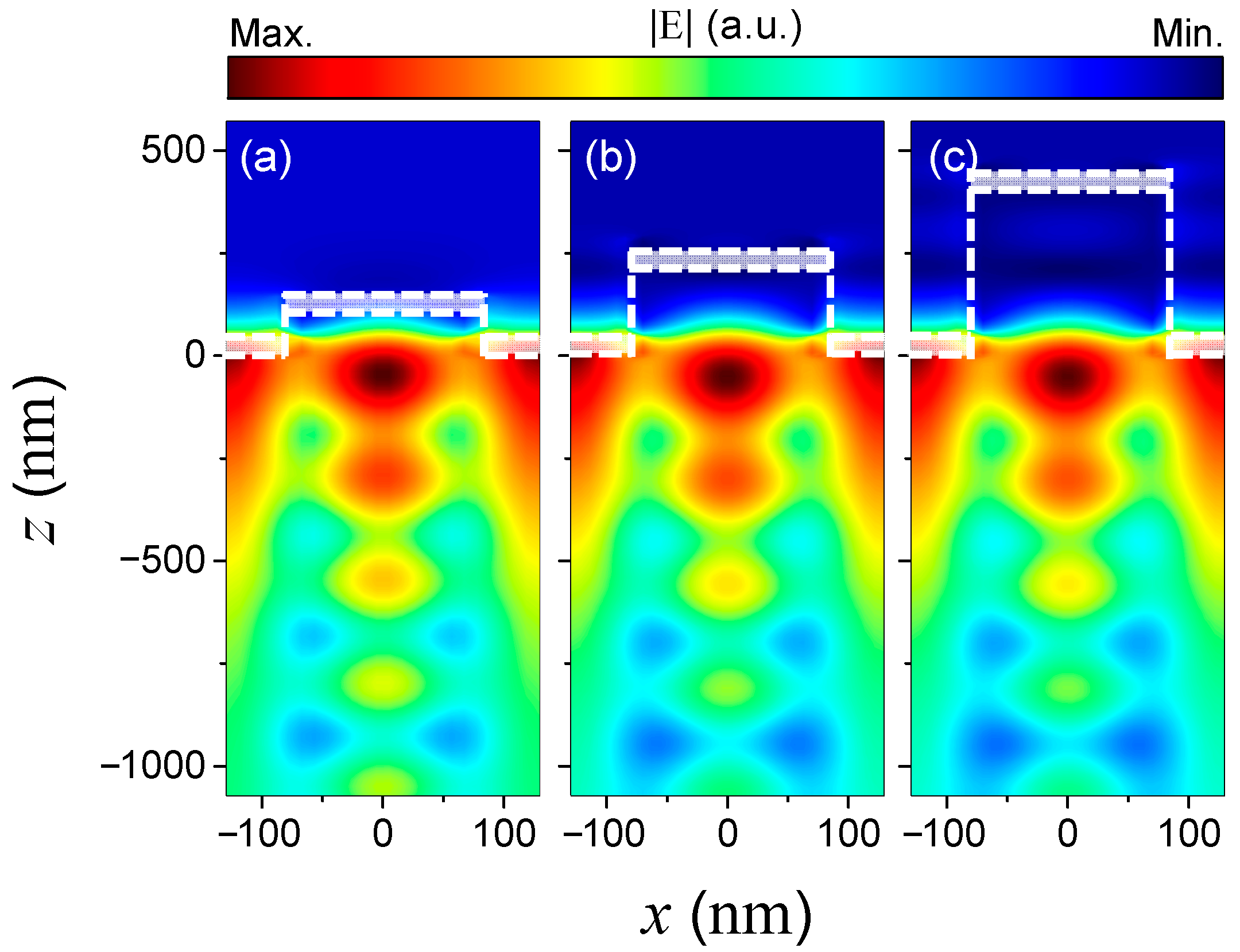
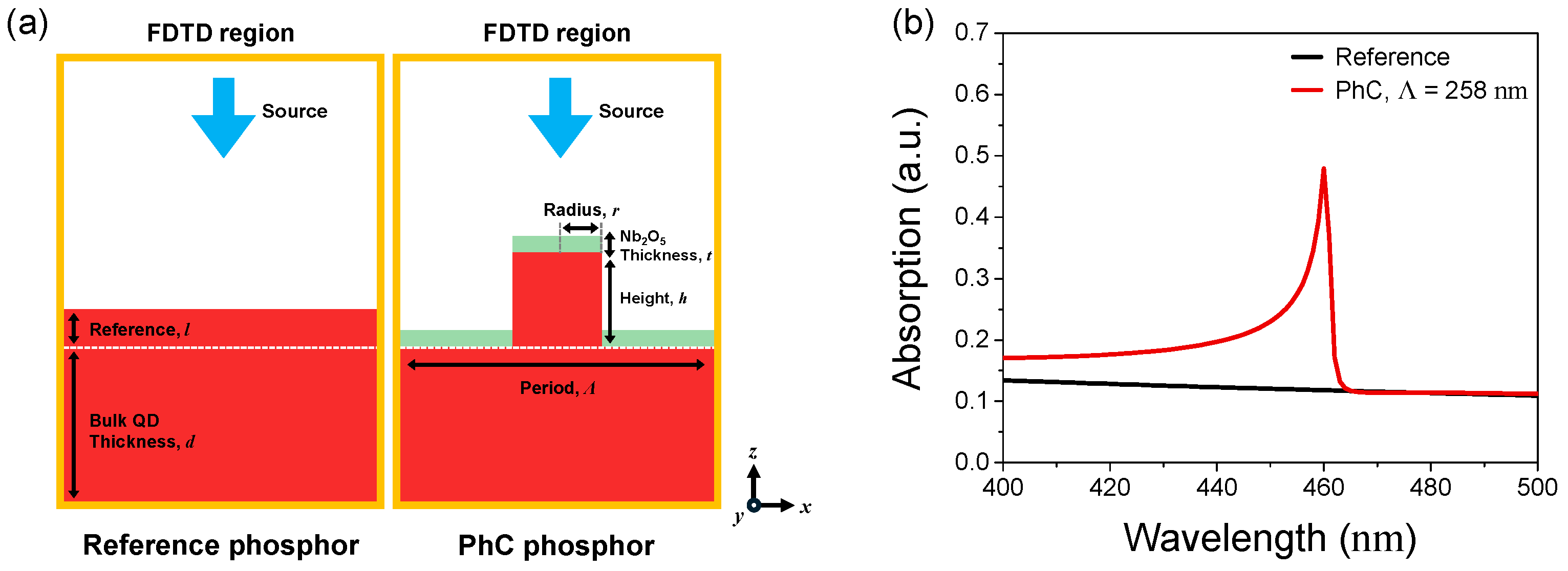
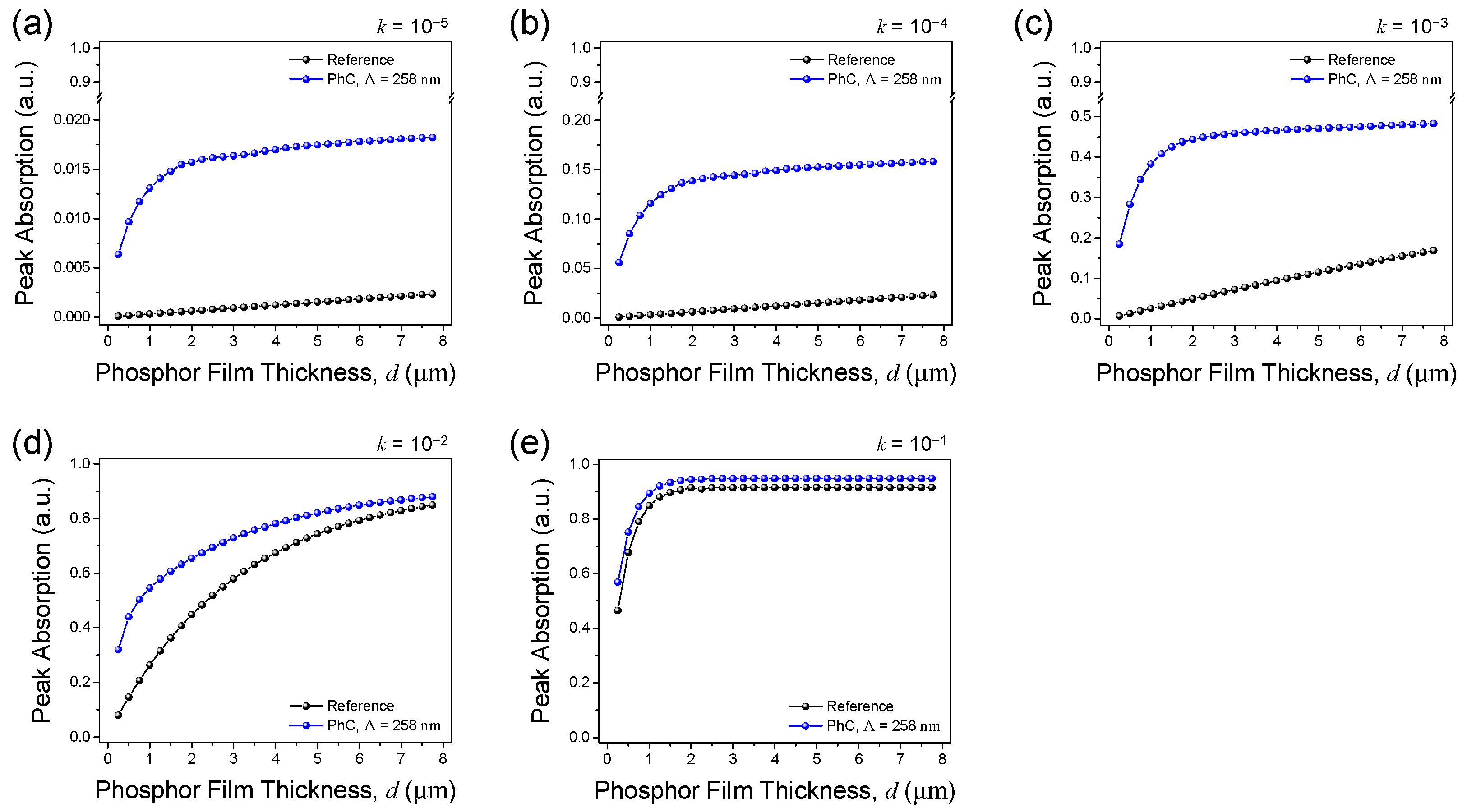
References
- Kumar, M.; Kumar, A.; Makki, A.H.; Seong, K.-S.; Park, S.-H. Quantum dot scaffold phosphors: Maximizing luminescence quantum yield via different stock environments. Mater. Lett. 2020, 259, 126846. [Google Scholar] [CrossRef]
- Chávez, D.; Garcia, C.R.; Oliva, J.; Diaz-Torres, L.A. A review of phosphorescent and fluorescent phosphors for fingerprint detection. Ceram. Int. 2021, 47, 10–41. [Google Scholar] [CrossRef]
- Hariyani, S.; Sójka, M.; Setlur, A.; Brgoch, J. A guide to comprehensive phosphor discovery for solid-state lighting. Nat. Rev. Mater. 2023, 8, 759–775. [Google Scholar] [CrossRef]
- Ryu, J.-E.; Park, S.; Park, Y.; Ryu, S.-W.; Hwang, K.; Jang, H.W. Technological breakthroughs in chip fabrication, transfer, and color conversion for high-performance micro-LED displays. Adv. Mater. 2023, 35, 2204947. [Google Scholar] [CrossRef] [PubMed]
- Kim, H.; Lee, S.; Shin, J.; Zhu, M.; Akl, M.; Lu, K.; Han, N.M.; Baek, Y.; Cang, C.S.; Suh, J.M.; et al. Graphene nanopattern as a universal epitaxy platform for single-crystal membrane production and defect reduction. Nat. Nanotechnol. 2022, 17, 1054–1059. [Google Scholar] [CrossRef]
- Meng, Y.; Feng, J.; Han, S.; Xu, Z.; Mao, W.; Zhang, T.; Kim, J.S.; Roh, I.; Zhao, Y.; Kim, D.-H.; et al. Photonic van der Waals integration from 2D materials to 3D nanomembranes. Nat. Rev. Mater. 2023, 8, 498–517. [Google Scholar] [CrossRef]
- Nair, G.B.; Swart, H.C.; Dhoble, S.J. A review on the advancements in phosphor-converted light emitting diodes (pc-LEDs): Phosphor synthesis, device fabrication and characterization. Prog. Mater. Sci. 2020, 109, 100622. [Google Scholar] [CrossRef]
- Huang, Y.-M.; Singh, K.J.; Liu, A.-C.; Lin, C.-C.; Chen, Z.; Wang, K.; Lin, Y.; Liu, Z.; Wu, T.; Kuo, H.C. Advances in quantum-dot-based displays. Nanomaterials 2020, 10, 1327. [Google Scholar] [CrossRef]
- Liu, Z.; Lin, C.-H.; Hyun, B.-R.; Sher, C.-W.; Lv, Z.; Luo, B.; Jiang, F.; Wu, T.; Ho, C.-H.; Kuo, H.-C.; et al. Micro-light-emitting diodes with quantum dots in display technology. Light Sci. Appl. 2020, 9, 83. [Google Scholar] [CrossRef]
- Charak, I.; Manhas, M.; Bedyal, A.K.; Singh, S.; Srivastava, A.; Swart, H.C.; Kumar, V. Structural and spectral studies of highly pure red-emitting Ca3B2O6: Eu3+ phosphors for white light emitting diodes. J. Alloys Compd. 2021, 869, 159363. [Google Scholar] [CrossRef]
- Panigrahi, K.; Nag, A. Challenges and strategies to design phosphors for future white light emitting diodes. J. Phys. Chem. C 2022, 126, 8553–8564. [Google Scholar] [CrossRef]
- Wang, Y.; Wang, Z.; Wei, G.; Yang, Y.; He, S.; Li, J.; Shi, Y.; Li, R.; Zhang, J.; Li, P. Highly efficient and stable near-infrared broadband garnet phosphor for multifunctional phosphor-converted light-emitting diodes. Adv. Opt. Mater. 2022, 10, 2200415. [Google Scholar] [CrossRef]
- Jiang, H.; Chen, L.; Zheng, G.; Luo, Z.; Wu, X.; Liu, Z.; Li, R.; Liu, Y.; Sun, P.; Jiang, J. Ultra-efficient GAGG: Cr3+ ceramic phosphor-converted laser diode: A promising high-power compact near-infrared light source enabling clear imaging. Adv. Opt. Mater. 2022, 10, 2102741. [Google Scholar] [CrossRef]
- Jang, E.; Jang, H. Review: Quantum dot light-emitting diodes. Chem. Rev. 2023, 123, 4663–4692. [Google Scholar] [CrossRef]
- Song, K.-H.; Peng, M.; Wang, J.-J.; Feng, L.-Z.; Yin, Y.-C.; Song, Y.-H.; Ru, X.-C.; Xie, Y.-P.; Zhang, G.; Deng, Z.; et al. Copper-Iodide Hybrid Clusters with Partial Distortion Enable High-Performance Full-Visible-Spectrum White-Light-Emitting Diodes. J. Am. Chem. Soc. 2024, 146, 34199–34208. [Google Scholar] [CrossRef]
- Zhao, K.; Ma, Z.; Yin, L.; Hui, B.; Si, H.; Tong, X.; Tang, H.; Cao, P.; Huang, S. Site preference and defect engineering of a highly efficient blue-emitting phosphor Sr2SiO4:Ce3+/K+ toward thermally enhanced luminescence. Inorg. Chem. Front. 2023, 10, 2314–2324. [Google Scholar] [CrossRef]
- Wang, S.; Xu, Y.; Chen, T.; Jiang, W.; Liu, J.; Zhang, X.; Jiang, W.; Wang, L. A red phosphor LaSc3(BO3)4:Eu3+ with zero-thermal-quenching and high quantum efficiency for LEDs. Chem. Eng. J. 2021, 404, 125912. [Google Scholar] [CrossRef]
- Oliver, R.D.J.; Caprioglio, P.; Peña-Camargo, F.; Buizza, L.R.V.; Zu, F.; Ramadan, A.J.; Motti, S.G.; Mahesh, S.; McCarthy, M.M.; Warby, J.H.; et al. Understanding and suppressing non-radiative losses in methylammonium-free wide-bandgap perovskite solar cells. Energy Environ. Sci. 2022, 15, 714–726. [Google Scholar] [CrossRef]
- Chen, M.; Lu, L.; Yu, H.; Li, C.; Zhao, N. Integration of colloidal quantum dots with photonic structures for optoelectronic and optical devices. Adv. Sci. 2021, 8, 2101560. [Google Scholar] [CrossRef] [PubMed]
- Lee, S.; Kim, C.U.; Bae, S.; Liu, Y.; Noh, Y.I.; Zhou, Z.; Leu, P.W.; Choi, K.J.; Lee, J.-K. Improving light absorption in a perovskite/Si tandem solar cell via light scattering and UV-down shifting by a mixture of SiO2 nanoparticles and phosphors. Adv. Funct. Mater. 2022, 32, 2204328. [Google Scholar] [CrossRef]
- Yang, X.; Shui, F.; Yu, Y.; Yi, Z.; Li, H.; Xu, Z.; Zhang, F.; Xiong, J.; Liu, X.; Wangyang, P.; et al. All layers patterned conical nanostructured thin-film silicon solar cells for light-trapping efficiency improvement. Opt. Express 2023, 31, 42111–42124. [Google Scholar] [CrossRef]
- Gaurav, A.; Chen, C.-S.; Tsai, C.-Y.; Ye, Z.-T.; Lin, C.-F. Stable colour conversion layer with enhanced conversion efficiency by incorporating nanoparticles for micro-LED display application. Mater. Today Chem. 2024, 39, 102184. [Google Scholar] [CrossRef]
- Hyun, B.-R.; Sher, C.-W.; Chang, Y.-W.; Lin, Y.; Liu, Z.; Kuo, H.-C. Dual role of quantum dots as color conversion layer and suppression of input light for full-color micro-LED displays. J. Phys. Chem. Lett. 2021, 12, 6946–6954. [Google Scholar] [CrossRef]
- Park, H.; Hahm, D.; Cho, H.; Shin, J.-W.; Kang, C.-M.; Ahn, D.-H.; Joo, C.-W.; Kwon, B.-H.; Kim, K.; Kim, J.Y.; et al. Efficient quantum dot color conversion layer with mixed spherical/rod-shaped scattering particles. ACS Appl. Opt. Mater. 2023, 1, 289–297. [Google Scholar] [CrossRef]
- Lee, T.-Y.; Miao, W.-C.; Hung, Y.-Y.; Bai, Y.-H.; Chen, P.-T.; Huang, W.-T.; Chen, K.-A.; Lin, C.-C.; Chen, F.-C.; Hong, Y.-H.; et al. Ameliorating uniformity and color conversion efficiency in quantum dot-based micro-LED displays through blue–UV hybrid structures. Nanomaterials 2023, 13, 2099. [Google Scholar] [CrossRef] [PubMed]
- Min, K.; Choi, S.; Choi, Y.; Jeon, H. Enhanced fluorescence from CdSe/ZnS quantum dot nanophosphors embedded in a one-dimensional photonic crystal backbone structure. Nanoscale 2014, 6, 14531–14537. [Google Scholar] [CrossRef] [PubMed]
- Min, K.; Jung, H.; Park, Y.; Cho, K.-S.; Roh, Y.-G.; Hwang, S.W.; Jeon, H. A colloidal quantum dot photonic crystal phosphor: Nanostructural engineering of the phosphor for enhanced color conversion. Nanoscale 2017, 9, 8703–8709. [Google Scholar] [CrossRef] [PubMed]
- Lee, J.; Min, K.; Park, Y.; Cho, K.-S.; Jeon, H. Photonic crystal phosphors integrated on a blue LED chip for efficient white light generation. Adv. Mater. 2018, 30, 1703506. [Google Scholar] [CrossRef]
- Mao, C.; Min, K.; Bae, K.; Cho, S.; Xu, T.; Jeon, H.; Park, W. Enhanced upconversion luminescence by two-dimensional photonic crystal structure. ACS Photonics 2019, 6, 1882–1888. [Google Scholar] [CrossRef]
- Lee, T.-Y.; Lee, J.; Park, Y.; Cho, K.-S.; Min, K.; Jeon, H. 2D square lattice photonic crystal phosphor films for efficient and excitation polarization insensitive color conversion. Adv. Opt. Mater. 2019, 7, 1900209. [Google Scholar] [CrossRef]
- Lee, H.; Lee, T.-Y.; Park, Y.; Cho, K.-S.; Rho, Y.-G.; Choo, H.; Jeon, H. Structurally engineered colloidal quantum dot phosphor using TiO2 photonic crystal backbone. Light Sci. Appl. 2022, 11, 318. [Google Scholar] [CrossRef]
- Lee, T.-Y.; Park, Y.; Jeon, H. Resonant cavity phosphor. Nat. Commun. 2023, 14, 6661. [Google Scholar] [CrossRef] [PubMed]
- Kim, T.; Lee, J.; Hwang, J.; Kim, D.; Hwang, K.; Min, K. Highly efficient color conversion of 3D photonic crystal phosphor films for micro-light-emitting diode applications. Adv. Photonics Res. 2024, 5, 2300297. [Google Scholar] [CrossRef]
- Yablonovitch, E. Inhibited spontaneous emission in solid-state physics and electronics. Phys. Rev. Lett. 1987, 58, 2059–2062. [Google Scholar] [CrossRef] [PubMed]
- John, S.; Quang, T. Spontaneous emission near the edge of a photonic band gap. Phys. Rev. A 1994, 50, 1764–1769. [Google Scholar] [CrossRef]
- Baba, T. Slow light in photonic crystals. Nat. Photonics 2008, 2, 465–473. [Google Scholar] [CrossRef]
- Do, Y.R.; Kim, Y.C.; Song, Y.-W.; Cho, C.-O.; Jeon, H.; Lee, Y.-J.; Kim, S.-H.; Lee, Y.-H. Enhanced light extraction from organic light-emitting diodes with 2D SiO2/SiNx photonic crystals. Adv. Mater. 2003, 15, 1214–1218. [Google Scholar] [CrossRef]
- Kim, D.-H.; Cho, C.-O.; Roh, Y.-G.; Jeon, H.; Park, Y.S.; Cho, J.; Im, J.S.; Sone, C.; Park, Y.; Choi, W.J.; et al. Enhanced light extraction from GaN-based light-emitting diodes with holographically generated two-dimensional photonic crystal patterns. Appl. Phys. Lett. 2005, 87, 203508. [Google Scholar] [CrossRef]
- Wierer Jr, J.J.; David, A.; Megens, M.M. III-nitride photonic-crystal light-emitting diodes with high extraction efficiency. Nat. Photonics 2009, 3, 163–169. [Google Scholar] [CrossRef]
- Kim, S.; Lee, J.; Jeon, H.; Kim, H.J. Fiber-coupled surface-emitting photonic crystal band edge laser for biochemical sensor applications. Appl. Phys. Lett. 2009, 94, 133503. [Google Scholar] [CrossRef]
- Matioli, E.; Brinkley, S.; Kelchner, K.M.; Hu, Y.-L.; Nakamura, S.; DenBaars, S.; Speck, J.; Weisbuch, C. High-brightness polarized light-emitting diodes. Light Sci. Appl. 2012, 1, e22. [Google Scholar] [CrossRef]
- Zhang, Q.; Tavakoli, M.M.; Gu, L.; Zhang, D.; Tang, L.; Gao, Y.; Guo, J.; Lin, Y.; Leung, S.-F.; Poddar, S.; et al. Efficient metal halide perovskite light-emitting diodes with significantly improved light extraction on nanophotonic substrates. Nat. Commun. 2019, 10, 727. [Google Scholar] [CrossRef] [PubMed]
- Wu, P.; Wang, J.; Jiang, L. Bio-inspired photonic crystal patterns. Mater. Horiz. 2020, 7, 338–365. [Google Scholar] [CrossRef]
- Qian, Z.; Shan, L.; Zhang, X.; Liu, Q.; Ma, Y.; Gong, Q.; Gu, Y. Spontaneous emission in micro-or nanophotonic structures. PhotoniX 2021, 2, 21. [Google Scholar] [CrossRef]
- Piper, J.R.; Fan, S. Total absorption in a graphene monolayer in the optical regime by critical coupling with a photonic crystal guided resonance. ACS Photonics 2014, 1, 347–353. [Google Scholar] [CrossRef]
- Piper, J.R.; Liu, V.; Fan, S. Total absorption by degenerate critical coupling. Appl. Phys. Lett. 2014, 104, 251110. [Google Scholar] [CrossRef]
- Liu, Y.; Chadha, A.; Zhao, D.; Piper, J.R.; Jia, Y.; Shuai, Y.; Menon, L.; Yang, H.; Ma, Z.; Fan, S.; et al. Approaching total absorption at near infrared in a large area monolayer graphene by critical coupling. Appl. Phys. Lett. 2014, 105, 181105. [Google Scholar] [CrossRef]
- Qing, Y.M.; Huang, Z.; Jiang, H.; Li, B. Polarization-dependent thermal-tunable graphene-based metamaterial exploiting critical coupling with guided mode resonances. J. Opt. Soc. Am. B 2023, 40, 233–238. [Google Scholar] [CrossRef]
- Qing, Y.M.; Ma, H.F.; Cui, T.J. Tailoring anisotropic perfect absorption in monolayer black phosphorus by critical coupling at terahertz frequencies. Opt. Express 2018, 26, 32442–32450. [Google Scholar] [CrossRef]
- Hu, Z.; Yin, Y.; Ali, M.U.; Peng, W.; Zhang, S.; Li, D.; Zou, T.; Li, Y.; Jiao, S.; Chen, S.-J.; et al. Inkjet printed uniform quantum dots as color conversion layers for full-color OLED displays. Nanoscale 2020, 12, 2103–2110. [Google Scholar] [CrossRef]
- Weng, Y.; Chen, S.; Zhang, Y.; Sun, L.; Wu, Y.; Yan, Q.; Guo, T.; Zhou, X.; Wu, C. Fabrication and color conversion of patterned InP/ZnS quantum dots photoresist film via a laser-assisted route. Opt. Laser Technol. 2021, 140, 107026. [Google Scholar] [CrossRef]
- Umar, M.; Min, K.; Jeon, H.; Kim, S. Single-mode distributed feedback laser operation with no dependence on the morphology of the gain medium. Ann. Phys. 2017, 529, 1700034. [Google Scholar] [CrossRef]
- Zimmennann, L.; Weibel, M.; Caseri, W.; Suter, U.W. High refractive index films of polymer nanocomposites. J. Mater. Res. 1993, 8, 1742–1748. [Google Scholar] [CrossRef]
- Min, K.; Choi, Y.K.; Jeon, H. Model calculations for enhanced fluorescence in photonic crystal phosphor. Opt. Express 2012, 20, 2452–2459. [Google Scholar] [CrossRef] [PubMed]
- Abood, M.; Salim, E.T.; Saimon, J.A. Optical investigations of Nb2O5 at different temperatures for optoelectronic devices. J. Ovonic Res. 2019, 15, 109–115. [Google Scholar]
- Taflove, A.; Hagness, S.C. Computational Electrodynamics: The Finite-Difference Time-Domain Method, 3rd ed.; Artech House Publishers: Norwood, MA, USA, 2005. [Google Scholar]
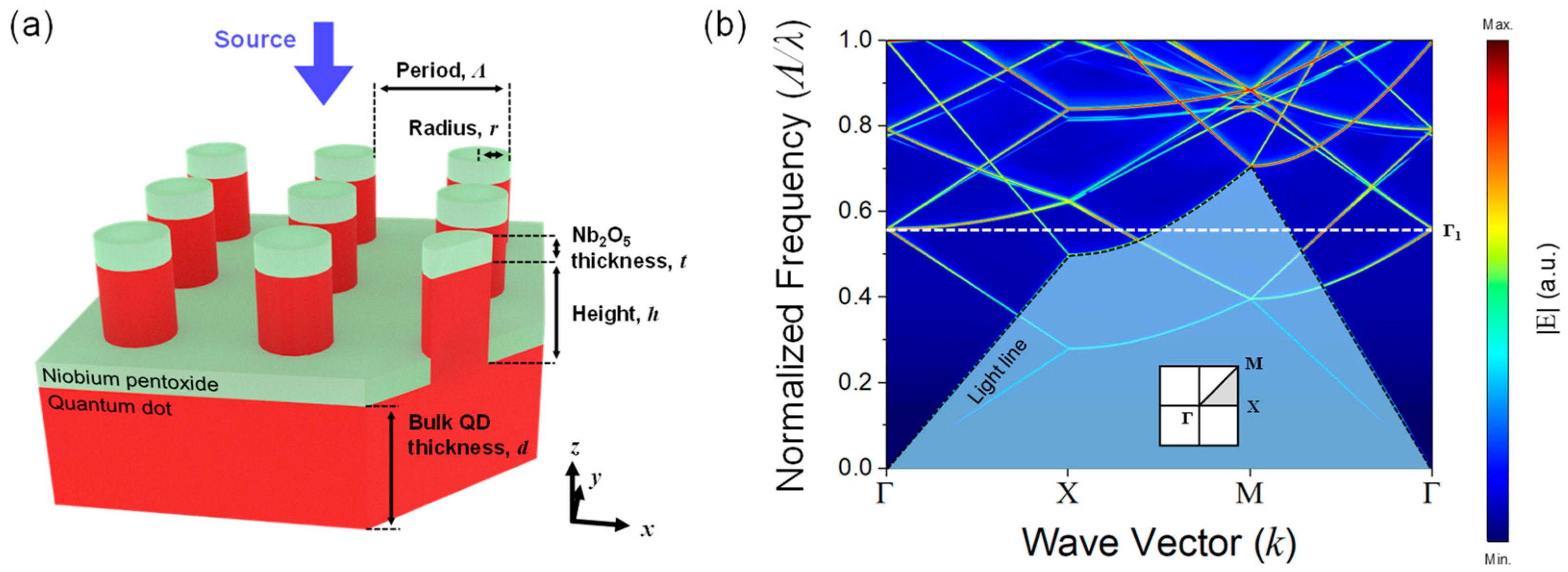
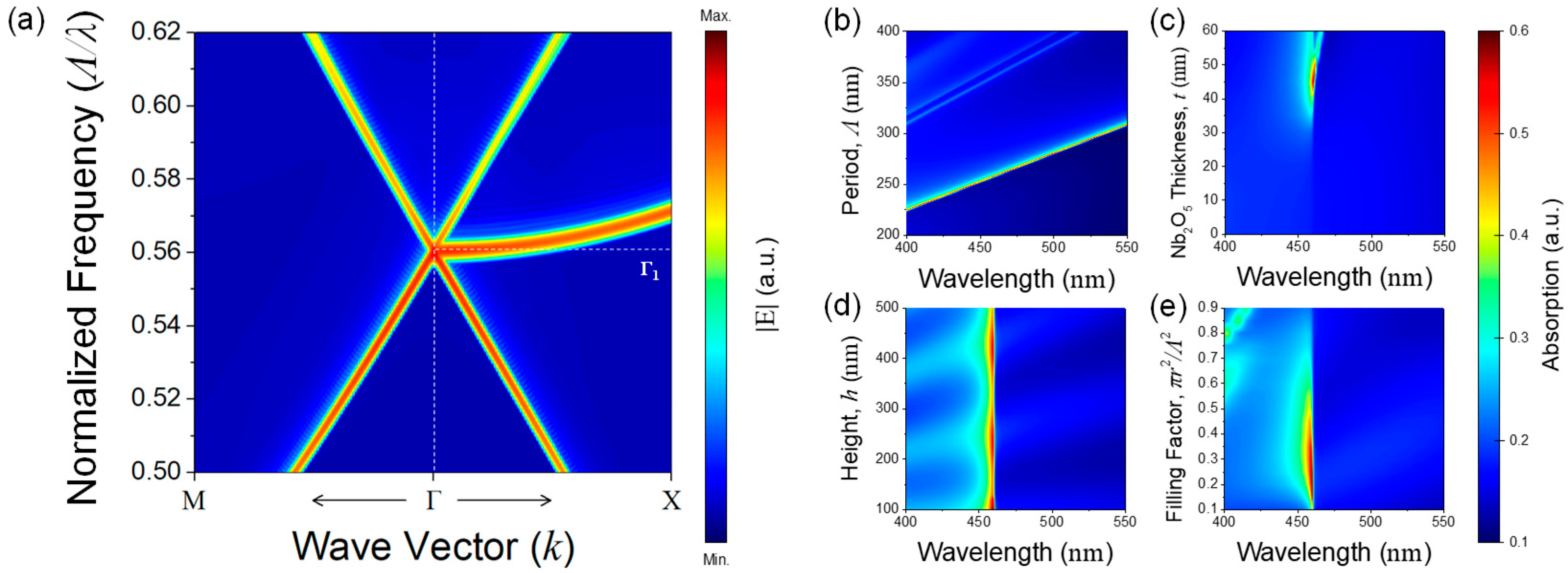


Disclaimer/Publisher’s Note: The statements, opinions and data contained in all publications are solely those of the individual author(s) and contributor(s) and not of MDPI and/or the editor(s). MDPI and/or the editor(s) disclaim responsibility for any injury to people or property resulting from any ideas, methods, instructions or products referred to in the content. |
© 2024 by the authors. Licensee MDPI, Basel, Switzerland. This article is an open access article distributed under the terms and conditions of the Creative Commons Attribution (CC BY) license (https://creativecommons.org/licenses/by/4.0/).
Share and Cite
Kim, T.; Lee, S.; Min, K. Model Calculation of Enhanced Light Absorption Efficiency in Two-Dimensional Photonic Crystal Phosphor Films. Photonics 2025, 12, 10. https://doi.org/10.3390/photonics12010010
Kim T, Lee S, Min K. Model Calculation of Enhanced Light Absorption Efficiency in Two-Dimensional Photonic Crystal Phosphor Films. Photonics. 2025; 12(1):10. https://doi.org/10.3390/photonics12010010
Chicago/Turabian StyleKim, Taehun, Sanghoon Lee, and Kyungtaek Min. 2025. "Model Calculation of Enhanced Light Absorption Efficiency in Two-Dimensional Photonic Crystal Phosphor Films" Photonics 12, no. 1: 10. https://doi.org/10.3390/photonics12010010
APA StyleKim, T., Lee, S., & Min, K. (2025). Model Calculation of Enhanced Light Absorption Efficiency in Two-Dimensional Photonic Crystal Phosphor Films. Photonics, 12(1), 10. https://doi.org/10.3390/photonics12010010




